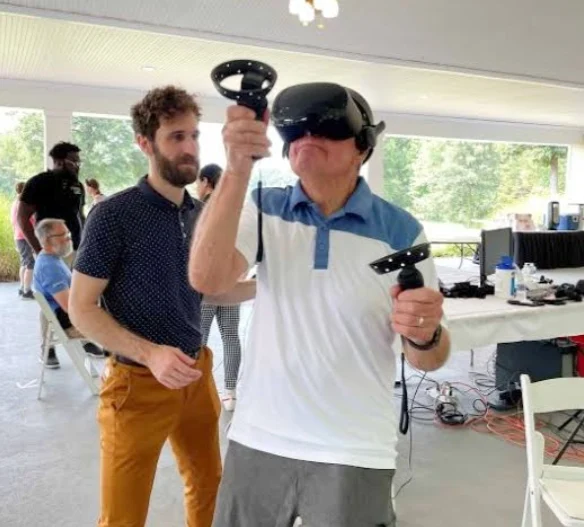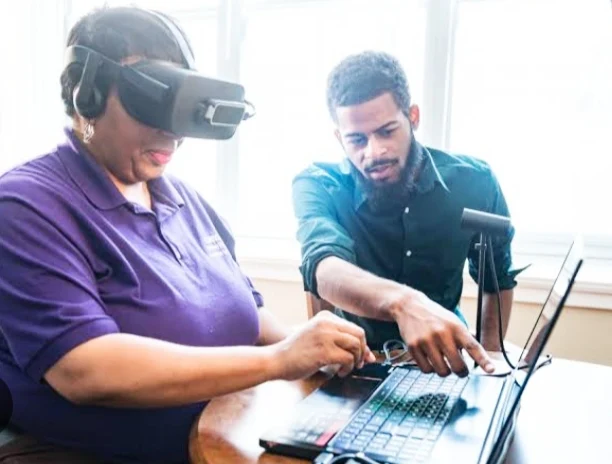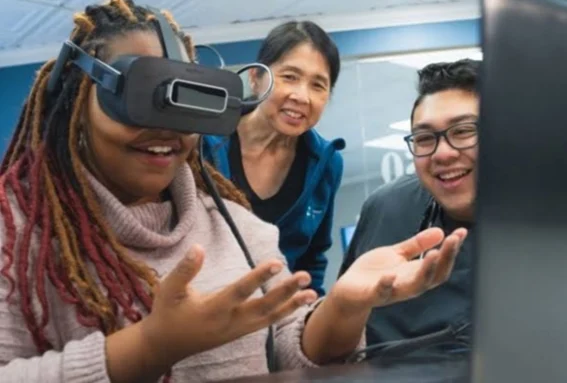Embodied Labs VR for Physical Therapy
Embodied Labs is a company at the forefront of utilizing virtual reality (VR) technology in healthcare training. Their focus, however, is not on training patients but on training therapists.
Embodied Labs VR for Physical Therapy: Historical Timeline
Embodied Labs is a relatively young company, and the field of VR for physical therapy is still emerging. However, here's a brief timeline highlighting some potential milestones:
2010s
- Early VR Development: VR technology advancements occur, making VR systems more affordable and accessible.
- VR in Healthcare: Initial exploration of VR applications in healthcare training and rehabilitation begins.
2020
- Embodied Labs Founded: Embodied Labs is founded with a focus on VR training for physical therapists.
- First Embodied Labs VR Products Released: Embodied Labs releases its first VR training products for physical therapists, focusing on specific procedures or conditions.
2021-2023
- Growth of VR in Physical Therapy: More physical therapy programs and institutions begin incorporating VR into their curriculum.
- Embodied Labs Expands Offerings: Embodied Labs expands its VR training library to encompass a wider range of physical therapy needs.
- Research on VR Effectiveness: Research studies are conducted to evaluate the effectiveness of VR training for physical therapists compared to traditional methods.
2024 (and Beyond)
- VR for Direct Patient Therapy: VR applications designed specifically for direct patient therapy in physical therapy clinics are developed and implemented.
- Integration with Physical Therapy Equipment: VR training programs are integrated with physical therapy equipment to provide a more comprehensive training experience.
- Standardization of VR in Physical Therapy: Best practices and guidelines for using VR in physical therapy education and treatment are established.
It's important to note that this timeline is speculative and based on general trends in VR technology and healthcare. The actual development of VR for physical therapy may occur more quickly or slowly than this timeline suggests.
Additionally, the following table summarizes the key points of the timeline:
| Year Range | Event |
|---|---|
| 2010s | Early VR development and initial exploration of VR in healthcare |
| 2020 | Embodied Labs founded and first VR products released |
| 2021-2023 | Growth of VR in physical therapy, Embodied Labs expands offerings, research on VR effectiveness |
| 2024 (and Beyond) | VR for direct patient therapy, integration with physical therapy equipment, standardization of VR in physical therapy |
Traditionally, physical therapists learn through textbooks, lectures, and observing experienced therapists. While these methods are valuable, they have limitations. VR offers a new approach that can enhance therapist training in several ways.
Benefits of VR for Physical Therapist Training
| Benefit | Description |
|---|---|
| Immersive Experience | VR places trainees in realistic scenarios, allowing them to experience a patient's condition firsthand. This can improve empathy and understanding. |
| Safe Environment | Trainees can practice procedures in a virtual environment without risk of injury to themselves or the patient. |
| Varied Situations | VR simulations can create a wide range of situations, allowing trainees to experience rare conditions or complex injuries. |
| Repetition | Trainees can repeat procedures as many times as needed to perfect their skills. |
| Data Collection | VR simulations can track trainee performance, allowing instructors to provide more targeted feedback. |
Embodied Labs leverages hand tracking technology to create a more natural and intuitive VR experience. This eliminates the need for controllers and allows trainees to interact with the virtual environment more freely.
While Embodied Labs' VR products are not currently intended for direct patient therapy, the potential for VR in physical therapy rehabilitation is promising. VR simulations could be used to:
- Motivate patients and make therapy more engaging.
- Provide patients with a safe environment to practice exercises.
- Offer biofeedback to patients, helping them improve their form.
Technology Uses for Embodied Labs VR for Physical Therapy
Embodied Labs leverages several key technologies to create a unique and effective VR experience for physical therapist training. Here's a breakdown of these technologies and their features:
| Technology | Description | Features |
|---|---|---|
| Virtual Reality (VR) | This core technology creates realistic and immersive simulations that place trainees in various physical therapy scenarios. | - Creates 360° environments for trainees to interact with. - Allows for simulation of different treatment settings (clinics, homes, etc.). - Can present a variety of patient conditions for trainees to practice on. |
| Hand Tracking | Embodied Labs utilizes hand tracking technology instead of controllers. This allows for a more natural and intuitive interaction within the VR environment, mimicking real-world therapist-patient interactions. | - Enables natural hand movements for manipulating virtual objects. - Provides greater dexterity and control compared to controllers. - Improves the feeling of presence and immersion within the VR simulation. |
| 3D Modeling | Highly detailed 3D models are used to create realistic virtual environments and patients with varying body types, genders, and potential injuries. | - Creates lifelike virtual environments that feel familiar and engaging. - Allows for customization of patient avatars with different body types and injuries. - Enables simulation of rare or complex conditions that may be difficult to find in real-world training settings. |
| Haptic Feedback (potential) | While not a current feature, future iterations of Embodied Labs VR may incorporate haptic feedback. This technology would allow trainees to feel virtual objects and potentially experience the sensations of performing specific therapeutic techniques. | - (Potential) Provides tactile feedback to enhance realism and training effectiveness. - (Potential) Allows trainees to feel the resistance of virtual muscles and joints. - (Potential) Offers a more immersive and kinesthetic learning experience. |
| Data Collection and Analytics | The VR simulations can track trainee performance metrics such as movement, hand placement, and adherence to proper procedures. This data can be used by instructors to provide personalized feedback and identify areas where trainees need improvement. | - Tracks trainee movements within the VR environment. - Analyzes hand placement and technique execution. - Provides data-driven insights for instructors to tailor their feedback. |
| Gamification (potential): Future applications of VR for physical therapy may incorporate elements of gamification. This could involve incorporating points, badges, or leaderboards to make training more engaging and motivating for therapists. | - (Potential) Integrates game mechanics to make training more interactive and enjoyable. - (Potential) Awards points for completing tasks and achieving goals. - (Potential) Uses leaderboards to foster friendly competition and encourage improvement. |
By combining these technologies, Embodied Labs VR offers a comprehensive training platform with unique features that go beyond traditional methods. This allows for a more immersive, interactive, and data-driven approach to physical therapist training.
Overall, Embodied Labs VR represents a significant step forward in healthcare training. By providing immersive and interactive simulations, VR can help therapists develop the skills and empathy they need to provide the best possible care for their patients.
Frequently Asked Questions about Embodied Labs VR for Physical Therapy
General VR Questions
- What is Embodied Labs VR? Embodied Labs VR is a platform that uses virtual reality technology to provide immersive experiences for physical therapy patients. These experiences can help patients with a variety of conditions, including pain management, stroke rehabilitation, and orthopedic injuries.
- How does Embodied Labs VR work? Embodied Labs VR uses realistic simulations and interactive activities to help patients improve their physical function, reduce pain, and enhance their quality of life. Patients can experience different environments and perform exercises in a safe and controlled setting.
- What equipment is needed to use Embodied Labs VR? To use Embodied Labs VR, you will need a VR headset and controllers. The specific equipment may vary depending on the therapy program.
Physical Therapy-Specific Questions
- How can Embodied Labs VR help with pain management? Embodied Labs VR can help patients manage pain by providing distractions and immersive experiences that can reduce their focus on pain. It can also help patients learn pain management techniques and coping strategies.
- How can Embodied Labs VR be used for stroke rehabilitation? Embodied Labs VR can help stroke patients improve their motor function, balance, and coordination through interactive activities that simulate real-world tasks.
- Can Embodied Labs VR be used for orthopedic rehabilitation? Yes, Embodied Labs VR can be used for orthopedic rehabilitation to help patients improve their range of motion, strength, and functional abilities.
- Is Embodied Labs VR effective for physical therapy? Studies have shown that Embodied Labs VR can be an effective tool for physical therapy. It can improve patient outcomes, increase engagement, and enhance the overall rehabilitation experience.
- Can Embodied Labs VR be used at home? Yes, some Embodied Labs VR programs can be used at home with the appropriate equipment. This can provide patients with more flexibility and convenience in their rehabilitation.




